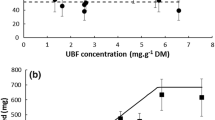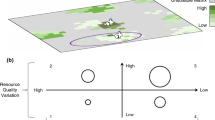Abstract
Adequate nutrition is a fundamental requirement for the maintenance and growth of populations, but complex interactions between nutrients and plant toxins make it difficult to link variation in plant quality to the ecology of wild herbivores. We asked whether a ‘foodscape’ model of habitat that uses near-infrared spectroscopy to describe the palatability of individual trees in the landscape, predicted the foraging decisions of a mammalian browser, the koala (Phascolarctos cinereus). Specifically, we considered four behavioural decision points at which nutritional quality may influence an animal’s decision. These were: which tree to enter, whether to feed from that tree, when to stop eating, and how long to remain in that tree. There were trends for koalas to feed in eucalypt trees that were more palatable than unvisited neighbouring conspecific trees, and than trees that they visited but did not eat. Koalas ate longer meals in more palatable trees, and stayed longer and spent more time feeding per visit to these trees. Using more traditional chemical analyses, we identified that an interaction between the concentrations of formylated phloroglucinol compounds (a group of plant secondary metabolites) and available N (an integrated measure of tannins, digestibility and N) influenced feeding. The study shows that foodscape models that combine spatial information with integrated measures of food quality are a powerful tool to predict the feeding behaviour of herbivores in a landscape.




Similar content being viewed by others
References
Callaghan J, McAlpine C, Mitchell D, Thompson J, Bowen M, Rhodes J, de Jong C, Domalewski R, Scott A (2011) Ranking and mapping koala habitat quality for conservation planning on the basis of indirect evidence of tree-species use: a case study of Noosa Shire, south-eastern Queensland. Wildl Res 38:89–102
Dearing MD (2013) Temperature-dependent toxicity in mammals with implications for herbivores: a review. J Comp Physiol B 183:43–50
DeGabriel JL, Wallis IR, Moore BD, Foley WJ (2008) A simple, integrative assay to quantify nutritional quality of browses for herbivores. Oecologia 156:107–116
DeGabriel JL, Moore BD, Foley WJ, Johnson CN (2009) The effects of plant defensive chemistry on nutrient availability predict reproductive success in a mammal. Ecology 90:711–719
Diner B, Berteaux D, Fyles J, Lindroth RL (2009) Behavioral archives link the chemistry and clonal structure of trembling aspen to the food choice of North American porcupine. Oecologia 160:687–695
Ebbers M, Wallis I, Dury S, Floyd R, Foley WJ (2002) Spectrometric prediction of secondary metabolites and nitrogen in fresh Eucalyptus foliage: towards remote sensing of the nutritional quality of foliage for leaf-eating marsupials. Aust J Bot 50:761–768
Felton AM, Felton A, Raubenheimer D, Simpson SJ, Foley WJ, Wood JT, Wallis IR, Lindenmeyer DB (2009) Protein content of diets dictates the daily energy intake of a free-ranging primate. Behav Ecol 20:685–690
Hindell MA, Handasyde KA, Lee AK (1985) Tree species selection by free-ranging koala populations in Victoria. Aust Wildl Res 12:137–144
Hladik CM (1977) A comparative study of two sympatric species of leaf monkeys: Presbytis entellus and Presbytis senex. In: Clutton-Brock TH (ed) Primate ecology: studies of feeding and ranging behaviour in lemurs, monkeys and apes. Academic Press, London, pp 323–352
Huang HZ, Turner BJ, Dury SJ, Wallis IR, Foley WJ (2004) Estimating foliar nitrogen concentration from HYMAP data using continuum removal analysis. Remote Sens Environ 93:18–29
Jakubas WJ, Gullion GW, Clausen TP (1989) Ruffed grouse feeding behavior and its relationship to the secondary metabolites of quaking aspen flower buds. J Chem Ecol 15:1899–1917
Knox NM, Skidmore AK, Prins HHT, Heitkonig IMA, Slotow R, van der Waal C, de Boer WF (2012) Remote sensing of forage nutrients: combining ecological and spectral absorption feature data. ISPRS J Photogramm Remote Sens 72:27–35
Lawler IR, Foley WJ, Woodrow IE, Cork SJ (1997) The effects of elevated CO2 atmospheres on the nutritional quality of Eucalyptus foliage and its interaction with soil nutrient and light availability. Oecologia 109:59–68
Lee AK, Martin RW, Handasyde KA (1990) Experimental translocation of koalas to new habitat. In: Lee AK, Handasyde KA, Sanson GD (eds) Biology of the koala. Surrey Beatty, Chipping Norton, pp 299–312
Logan M, Sanson GD (2002) The effect of tooth wear on the feeding behaviour of free-ranging koalas (Phascolarctos cinereus, Goldfuss). J Zool 256:63–69
Lunney D, Matthews A, Moon C, Ferrier S (2000) Incorporating habitat mapping into practical koala conservation on private lands. Conserv Biol 14:669–680
Marsh KJ, Wallis IR, Foley WJ (2007) Behavioural contributions to the regulated intake of plant secondary metabolites in koalas. Oecologia 154:283–290
Marsh KJ, Moore BD, Wallis IR, Foley WJ (2013) Continuous monitoring of feeding by koalas highlights diurnal differences in tree preferences. Wildl Res (in press)
Martin RW (1981) Age-specific fertility in three populations of koala, Phascolarctos cinereus (Goldfuss), in Victoria. Aust Wildl Res 8:275–283
Matthews A, Lunney D, Gresser S, Maitz W (2007) Tree use by koalas (Phascolarctos cinereus) after fire in remnant coastal forest. Wildl Res 34:84–93
McArt SH, Spalinger DE, Collins WB, Schoen ER, Stevenson T, Bucho M (2009) Summer dietary nitrogen availability as a potential bottom-up constraint on moose in south-central Alaska. Ecology 90:1400–1411
Moore BD, Foley WJ (2005) Tree use by koalas in a chemically complex landscape. Nature 435:488–490
Moore BD, Wallis IR, Pala-Paul J, Brophy JJ, Willis RH, Foley WJ (2004) Antiherbivore chemistry of Eucalyptus-cues and deterrents for marsupial folivores. J Chem Ecol 30:1743–1769
Moore BD, Foley WJ, Wallis IR, Cowling A, Handasyde KA (2005) Eucalyptus foliar chemistry explains selective feeding by koalas. Biol Lett 1:64–67
Moore BD, Lawler IR, Wallis IR, Beale CM, Foley WJ (2010) Palatability mapping: a koala’s eye view of spatial variation in habitat quality. Ecology 91:3165–3176
Nagy KA, Martin RW (1985) Field metabolic rate, water flux, food consumption and time budget of koalas, Phascolarctos cinereus (Marsupialia: Phascolarctidae) in Victoria. Aust J Zool 33:655–665
Nakagawa N (2009) Feeding rates as valuable information in primate feeding ecology. Primates 50:131–141
Nersesian CL, Banks PB, Simpson SJ, McArthur C (2012) Mixing nutrients mitigates the intake constraints of a plant toxin in a generalist herbivore. Behav Ecol 23:879–888
Phillips S, Callaghan J (2000) Tree species preferences of koalas (Phascolarctos cinereus) in the Campbelltown area south-west of Sydney, New South Wales. Wildl Res 27:509–516
Snyder MA (1992) Selective herbivory by Abert’s squirrel mediated by chemical variability in ponderosa pine. Ecology 73:1730–1741
Wallis IR, Foley WJ (2005) The rapid determination of sideroxylonals in Eucalyptus foliage by extraction with sonication followed by HPLC. Phytochem Anal 16:49–54
Wallis IR, Watson ML, Foley WJ (2002) Secondary metabolites in Eucalyptus melliodora: field distribution and laboratory feeding choices by a generalist herbivore, the common brushtail possum. Aust J Zool 50:507–519
Youngentob KN, Renzullo LJ, Held AA, Jia XP, Lindenmeyer DB, Foley WJ (2012) Using spectroscopy to estimate measures of foliage nutritional quality. Methods Ecol Evol 3:416–426
Acknowledgments
We appreciate the help of the volunteers who followed koalas, particularly Fred Ford, Frances Marsh and Kriszti Keszei. This work would not have been possible without help and support from Ashley Reed, Pete Cleary and Lisa Brooks, rangers at the Koala Conservation Centre. Phillip Island Nature Park allowed access to the Koala Conservation Centre and provided accommodation for K. J. M. and the volunteers. Thanks to Dr Jeff Wood and Ms Christine Donnelly from the Australian National University Statistical Consulting Unit, for advice on statistical analyses. A grant from the Australian Research Council to W. J. F. funded the work.
Author information
Authors and Affiliations
Corresponding author
Additional information
Communicated by Jörg Ganzhorn.
Rights and permissions
About this article
Cite this article
Marsh, K.J., Moore, B.D., Wallis, I.R. et al. Feeding rates of a mammalian browser confirm the predictions of a ‘foodscape’ model of its habitat. Oecologia 174, 873–882 (2014). https://doi.org/10.1007/s00442-013-2808-3
Received:
Accepted:
Published:
Issue Date:
DOI: https://doi.org/10.1007/s00442-013-2808-3




